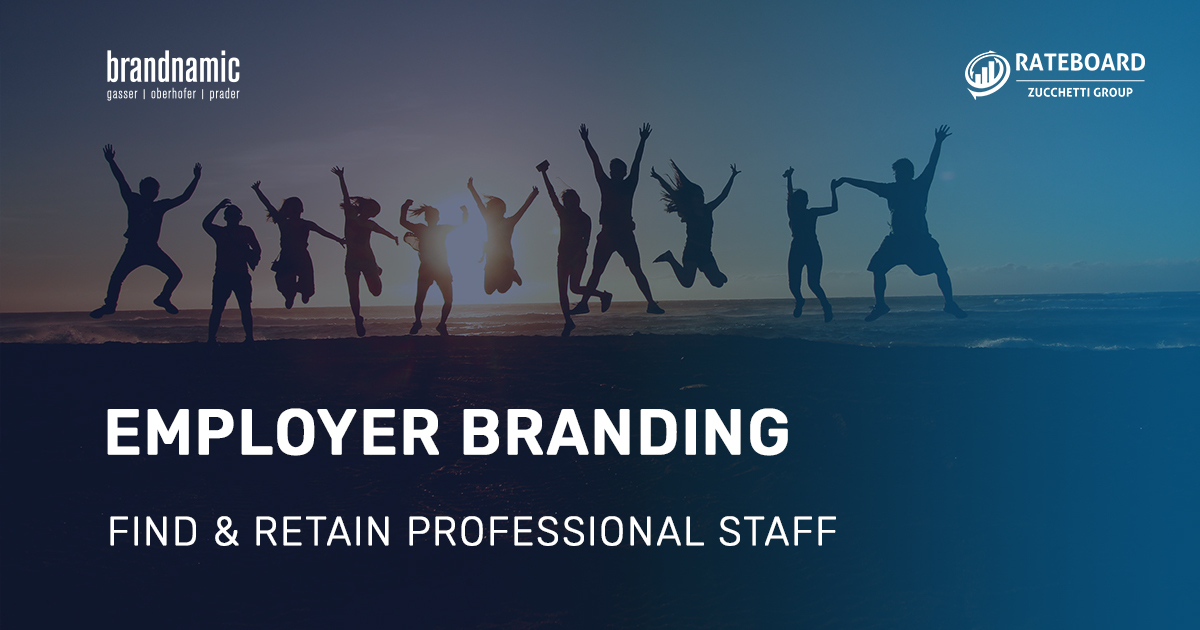
Alexandra
Junior Marketing Manager
October 18, 2022
RateBoard Insights
Employer Branding - Finding trained professionals
Recently we were able to win the hotel marketing agency Brandnamic and the HR expert Stephanie Ganterer for a webinar. The very topical issue is summarized in the following blog post.
Business facilities are one of the most important requirements of any successful hospitality business. A place that meets the needs of the guests, appealing details, extraordinary accents - the standard is far beyond practicality. However, the impressive service, i.e. the employee performance, is the freestyle, because: People make the difference. Anyone who is able to inspire people will be rewarded with returning guests. For this reason, it is not enough to rely on expertise and specializations, but also to train soft skills and team spirit.
“No one can whistle a symphony. It takes an orchestra to play it."
Halford E Luccock

Employer branding is about two key issues: finding trained professionals and retaining them. In order to find skilled employees, the right channels have to be identified first - and in order for the right applicants to get in touch, external communication is of utmost importance.
The second step is to retain skilled workers, which means keeping them in the company. There is currently a very high fluctuation in the labor market, but a strong wind of change can be seen as enrichment for the team.
Employer branding brings many benefits. Not only does it increase productivity because the company becomes more competitive with qualified and motivated employees, it also increases its attractiveness on the labor market. Furthermore, staying on top of the topic brings expert knowledge to the company.
Building blocks for successful employer branding
Organization is like the “mise en place” and the cornerstone for all further planning steps in human resources. In plain language, this means that a good basis has to be created in the company by assigning key positions, handing over responsibilities, aligning external communication channels and clearly defining the goals that the company pursues.
The route is the reward
It has to be clear where the company wants to go, because one cannot achieve a goal which has not been defined. The vision of a company must be based on the corporate values. Set values are not set in stone and can also be changed later. Benefits are important for external communication, as long as they are achievable internally. This means that nothing should be promised that cannot be kept. Trust in managers, in employees and in each other is the basis for successful employer branding.
Expert tipp:
"Let employees contribute ideas so that they feel like designers and their self-confidence is encouraged."
USP - What makes us special in the market? When considering the USPs, it is about working out what distinguishes the company as an employer, what it stands for and, above all, why employees should work in the company and eventually, stay with it. Not every type of professional can be found through the same communication channel. It is important to use the appropriate channel for each vacancy.
Internal communication
Internal communication has to run parallel to external communication, because only if it blends in internally it will reflect positively to the outside world, which creates a positive image and working atmosphere and keeps team turnover low. It is also important to have a good standing in future specialist and managerial positions, i.e. people who have graduated from school or are about to.
Perspectives are the key to loyal, motivated employees. The range of perspectives and development potential strengthens self-confidence, commitment, motivation and loyalty to one's own company. It enables employees to advance their personal careers in the company where they can be sure of receiving support and future opportunities! Training and development are therefore excellent strategies for employee retention.
Expert tipp:
"Bonus for current employees who recruit new specialists - always pays off."
Internal communication can take place, for example, via an intranet. If something new comes up to the company, it should be communicated directly and not postponed. Alternatively, communication can also take place via a weekly employee newsletter, Whatsapp messages or a post in an internal Facebook group. Not only the communication channel but also the frequency of the exchange play a role. A fixed jour fixe, depending on how often and how long meetings are needed, as well as specifying a person responsible for the meeting culture, can bring structure to communication.
Meeting points can be created within the company premises, for example specially marked employee rooms, which on the one hand invite to exchange ideas, but on the other hand also serve as a place of retreat. Meeting points outside the company include events for employees, which can either be organized as a company or openly for their families.
External communication
In order to establish successful external communication, a communication concept must be created for employees and for the brand itself. A job landing page with values, facts, visions, a blog and links to social media accounts helps candidates to obtain thorough information. Another measure of external communication is the establishment of a corporate social network and an image film as an emotional factor.
A newsletter can be used as a means of communication for current employees to keep them informed about what is currently happening in the company. Other measures can include visiting trade fairs and schools, keeping trainees blogs, and building a talent community, which serves to keep in touch with applicants who are not currently working in the company.
Important rules:
Away from the monotony towards authentic messages:
You can dare to communicate on your own channels and
stand out with authentic messages.
Keep going!
When a communication channel is started, it is
to maintain it and to stay in communication with the audience,
for example through videos or photo shoots.
Corporate culture
Corporate culture is about defining what values the company represents and what it stands for. Certain framework conditions must be in place for employees to feel comfortable. These include employee accommodation, break rooms, employee meals and the working time models offered.
An important measure to strengthen the corporate culture are internal rituals, such as meetings and appraisals. Giving feedback, but also asking it from employees, both positive and negative, provides orientation and creates trust. Dealing with mistakes is also part of the corporate culture. Mistakes are allowed and can be used as a teaching example.
The topic of further development is probably the most important key point in the area of corporate culture when deciding for or against an employer. The shortage of skilled workers harbors risks: It opens up countless opportunities for highly qualified employees, which is why the further development of one's own human capital should not be dispensed with. Anyone who spends time, money and energy on their employees today will only benefit from the result tomorrow - but will be rewarded with growth.
SHARE

Subscribe To Our Newsletter
Sign up now and receive monthly hotel and revenue management insights.
